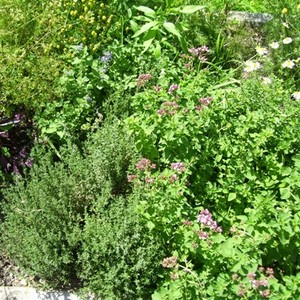Italian Seasoning is a combination of several different herbs. While most people would use it for dishes such as spaghetti or lasagna it is a versatile combination that is great on most any meat dish, eggs, stews, and sprinkled on garlic bread for added flavor. While many people are happy purchasing their Italian Seasoning at the grocery store in a jar or bottle others may me interested in going back to nature and growing their own herbs to use as Italian Seasoning.
Herb gardens come in all shapes and sizes and can include a multitude of herbs for as many different uses. Most processed Italian Seasonings I found contain Thyme, Parsley, Oregano, Rosemary, Marjoram, Basel, and Sage. All of these grow nicely in most areas of the country and don’t require a lot of attention. And each of these herbs can be used for different purposes alone or together.
When growing herbs you really should look at them as more than just something to add to food. The majority of herb plants make spectacular additions to landscape designs also. Herbs don’t have to be grown just in a herb garden and can be planted among other plants and flowers. Many herbs also flower during the season so can be used for an additional display of color as borders or in beds.
Yet another great aspect of herb gardens or herbs in general is the aroma, not just when used in cooking but just walking near some herbs can bring a wealth of smells that will linger in the air. If planting an Italian Seasoning herb garden you will be able to enjoy the smells all through the growing season as well as into the winter months when you dry your herbs.
Thyme is a herb that is great with lemon, garlic, and basil, or can be used as a garnish in salads and chowders. You can use Thyme with any meat, casseroles, soups, vegetables, soups and stews. The Thyme plant grows to between 6 and 12 inches tall and sends out many side branches so likes space to grow. In mid summer thyme will produce small pink to lilac colored flowers and is very aromatic – you can smell it several yards away from the plant.
Parsley is great in Middle Eastern and French dishes as well as Italian foods but also makes an attractive garnish to any plate. The Parsley plant doesn’t put off any flowers or smell but most varieties offer an attractive mound of green that is attractive planted with flowering plants.
Oregano is probably best known for its use on pizza and in spaghetti but it also works wonderfully adding flavor to vegetables, meats, and egg dishes. The Oregano plant can grow to as much as 3 feet tall and with regular cutting will become quite bushy. The attractive flowers of the oregano plant come in shades from white to purple last for several months in the summer.
Rosemary is a very versatile herb that goes great with many different types of meat, fish, cheese, vegetables, and eggs. In the best of conditions a Rosemary plant can grow to the height of as much as 6 feet tall and 5 feet wide. Rosemary is an evergreen so can add color to your garden or landscape year round.
Marjoram is very similar to oregano but has a bit milder flavor. The Marjoram plant grows to about 2 feet tall but the branches cascade over so this herb is an excellent choice for container gardening or in raised beds. If grown in beds when the branches touch the ground they will also take root so the Marjoram plant will spread and spread covering a large area in time.
Basil is a herb with a variety of uses. Not only as a garnish, Basil is wonderful on meat, vegetable, pasta, and egg dishes. Of all the Italian Seasoning herbs basil is probably the most temperamental to grow it not as much so as some would have you think. The Basil plant doesn’t like too much heat or to be too dry so may take some extra watching but is worth it as basil produces beautiful white flowers that attract bees which are beneficial to the garden. Basil does however make an excellent herb for the window sill in the winter so you can have fresh basil year round.
Sage can be used in cooking meats, poultry, and a wide range of vegetables. The sage plant offers flowers in shades of blue, pink, and also white. Sage makes an excellent container plant and can be attractive in a pot setting on a porch or deck. The sage plant also likes to be pruned so having it close to the kitchen is a convenient place to regularly harvest fresh leaves for cooking.
As you can see the herbs in Italian seasoning have a variety of uses and can be grown in a herb garden, flower beds, or individual containers. Once you have your herbs growing there are a variety of ways you can preserve the herbs to use year round. Some people prefer drying; either with a dehydrator or hanging, while others simply freeze the herbs in plastic bags and take out what they need as they need them. No matter what you do with your herbs there is no doubt you will find a great use for the herbs in Italian Seasoning.
